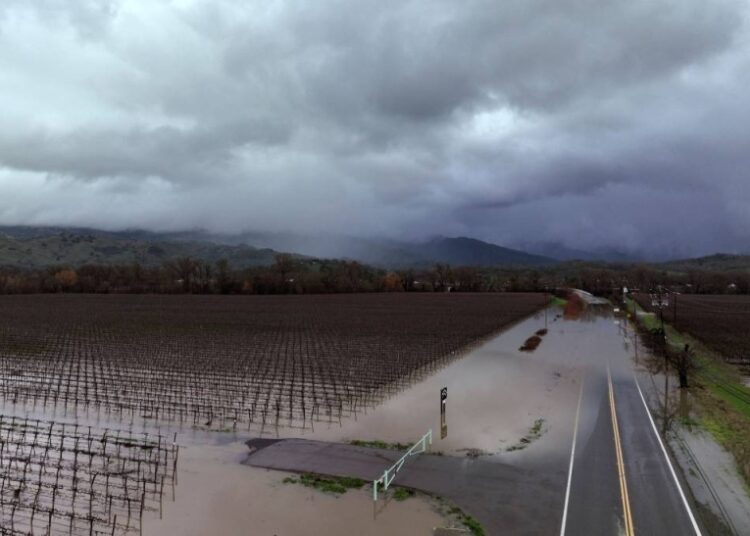SALINAS (United States — US President Joe Biden has declared a major disaster in California, as the latest in a succession of storm systems blew into the state, bringing heavy flooding to already waterlogged regions and threatening snowfalls of up to six feet (two meters).
The latest system was expected to bring “heavy lower-elevation rain, significant mountain snow, and strong winds,” with “another surge of Pacific moisture” expected Monday, the National Weather Service (NWS) said.
It predicted “disastrous flooding” across the lower Salinas River valley, a key agricultural region south of San Francisco Bay.
Late yesterday, Biden “declared that a major disaster exists in the State of California and ordered Federal aid to supplement State, tribal, and local recovery efforts in the areas affected by severe winter storms, flooding, landslides, and mudslides,” the White House said in a statement.
The declaration makes federal funding available for relief to affected people, including temporary housing and repairs.
At least 19 people are known to have died from storm-related causes in the last three weeks.
Among them were drivers found in submerged cars, people struck by falling trees, and a husband and wife killed in a rockfall.
Rising waters and unsuitable conditions resulted in a halt in the search for five-year-old Kyle Doan, who was swept away in floodwaters as his mother tried to pull him to safety from their car, the San Luis Obispo County Sheriff’s office said yesterday.
An AFP journalist saw the Salinas River overflowing its banks in many spots, at times covering farm fields for hundreds of yards, even as the rain continued under leaden skies.
In Spreckels, a community a few hundred yards from the river, most residents had opted not to evacuate despite warnings from authorities.
“It looks like we might have missed kind of the worst of it,” said Robert Zagajeski, out walking his dog under a light rain.
A few miles away, 30-year-old farm worker Erick Diaz watched the flooded fields from his home near the river. Despite evacuation orders, he too had remained.
“I have nowhere to go and for the moment everything is fine,” he said.
But Governor Gavin Newsom warned Californians that they were not in the clear yet: “We’re not done,” he said Saturday after visiting impacted residents.
Urging them to remain vigilant, he said Californians should continue to exercise “common sense over the course of the next 24 to 48 hours.”
Nearly 26 million Californians remained under a flood watch Saturday evening, according to the NWS, with tens of thousands under evacuation orders and advisories.
The storms of recent weeks were originally welcomed—coming after years of drought—but by now have brought “disastrous” flooding, officials have said.
Around 0800 GMT Sunday, there were more than 16,000 homes without power in California, according to poweroutage.us.
“This place was hit hard by the drought over the past years,” 58-year-old farm worker Manuel Paris told AFP near Salinas. “We’re not used to this much rain anymore.”
The NWS said another two to three inches of rain (5.0 to 7.5 centimetres) could cause new flooding and mudslides, with parts of the Sierra Nevada seeing three to six feet of snow, and heavy winds buffeting central and coastal California at up to 50 miles (80 kilometres) per hour.
Dangerous travel
The most populous US state has been pummelled by near-record downpours over three weeks—an average of nine inches of rain has fallen—with the Salinas Valley among the hardest hit.
On Friday, forecasters warned that the Monterey Peninsula could be cut off and the whole city of Salinas—home to 160,000 people—could be hit by flooding.
But yesterday, an AFP journalist said the city itself had so far been largely spared.
Between storms, workers have rushed to clear some of the mess, shovelling mud from roads even in the heart of Los Angeles and using heavy machinery to remove fallen trees or clear rockslides.
An AFP journalist saw tractors in fields near Salinas fighting to pump floodwaters back into the river. Newly falling rain was not helping the effort.
And forecasters say the unsettled weather in the US West—associated with what is called an atmospheric river pattern—is not done.
Over the mountains, heavy snow was making travel dangerous or impossible on a three-day holiday weekend honouring civil rights leader Martin Luther King Jr.
Officials urged people to stay home due to a heightened risk of avalanches.
Authorities in the Lake Tahoe resort area posted pictures showing dozens of vehicles lined up on a road, stalled by a fierce blizzard.
Winter storms are not unusual in California. But global warming is making them wetter and wilder.
At the same time, the western United States has been growing more arid for years.






Discussion about this post